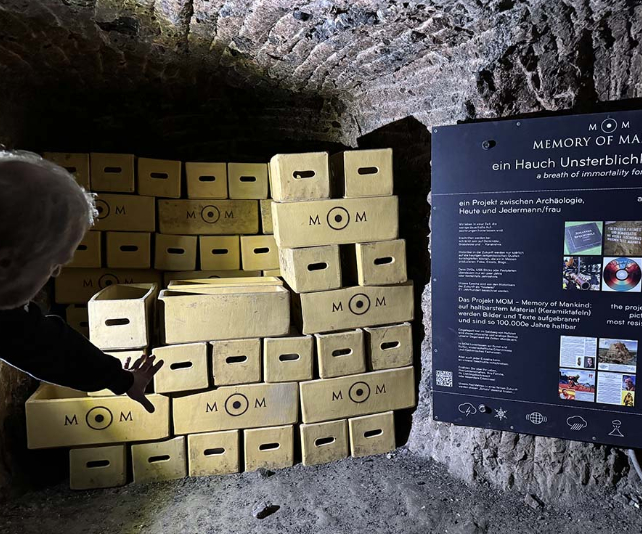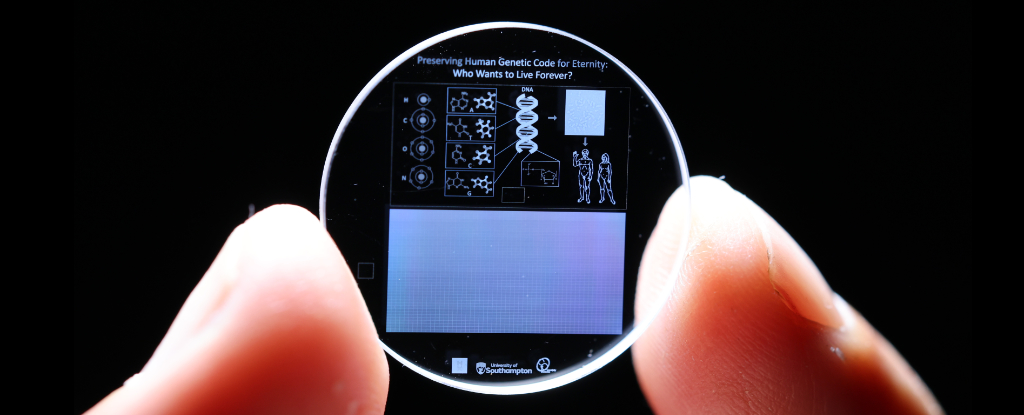Products You May Like
Long after Earth’s oceans have vaporized and all its plant and animal life has turned to dust under the Sun’s slow expansion, a tiny disc of silica could continue to represent a landmark moment in human evolutionary history.
Researchers at the University of Southampton in the UK have once again demonstrated the incredible storage capabilities of their five-dimensional (5D) memory crystal, this time by etching a sequence representing the complete modern human genome into its structure.
The technology itself isn’t exactly new, though it hasn’t ceased to be impressive. By 2011, engineers had perfected methods of using femtosecond-long pulses from a laser to create nanoscale voids in a glassy material made of silicon dioxide, also known simply as silica.
Depending on the amount of energy deposited in this void, differences in the spaces can be created.
The three-dimensional position of the nanoscale structures, along with their size and orientation, allow for 5D data storage. With voids as small as 20 nanometers across, the largest of these memory crystals are claimed to be capable of holding hundreds of terabytes of information.
And unlike the unstable chemistry of magnetic tape, or the photosensitive dyes in compact discs, the swiss-cheese arrangement of the silicon and oxygen-based molecules barely wavers over time, no matter what’s thrown at it. Freeze it, stomp on it, bake it at 1,000 degrees Celsius, those holes will still be readable if you’ve got the right equipment.
The data can be read using an optical microscope and a polarizer. Patterns printed on the 5D disc appear differently depending on the angle of view and the magnification of the microscope it’s viewed with.
In theory, the material could sit at room temperature for many billions of years and remain more or less intact, proving more robust than any other compact method of data storage invented to date.
frameborder=”0″ allow=”accelerometer; autoplay; clipboard-write; encrypted-media; gyroscope; picture-in-picture; web-share” referrerpolicy=”strict-origin-when-cross-origin” allowfullscreen>
Working with the DNA technology company Helixwork Technologies, researchers from the University of Southampton embedded a sequence of around 3 billion letters representing a human genome into a single crystal, totalling somewhere around 800 megabytes of data.
The resulting memory crystal has since been stashed away in the Memory of Mankind’s archive in Austria, joining hundreds of inscribed ceramic tomes stored in the old salt mine for distant generations to pick through.

Whether such a record could be used by any kind of advanced intelligence to resurrect Homo sapiens – or any other species we might want to save away – is highly speculative, based on our current state of knowledge.
On the other hand, it’s impossible to know what future minds might make of having a repository of long-lost genes in their comparatively alien hands.
“We know from the work of others that genetic material of simple organisms can be synthesized and used in an existing cell to create a viable living specimen in a lab,” says team leader Peter Kazansky, an optical physicist at the University of Southampton.
“The 5D memory crystal opens up possibilities for other researchers to build an everlasting repository of genomic information from which complex organisms like plants and animals might be restored should science in the future allow.”
Visions of post-apocalyptic human clones aside, the technology could prove invaluable even in the near future.
Just four years ago, humanity churned out around 64 zetabytes of data, representing everything from Netflix series to TikTok clips, from amazing ScienceAlert articles to Facebook gossip. This year it could be nearly 150 zetabytes – an explosive trend that shows no sign of slowing down.
All of that data could prove handy in decades to come, requiring cheap, robust, low-energy methods for packing away a lot of information in the smallest of spaces.
And if some of it happens to survive a billion years to once again see the light of day, what better discovery than an instruction manual for a human being?
